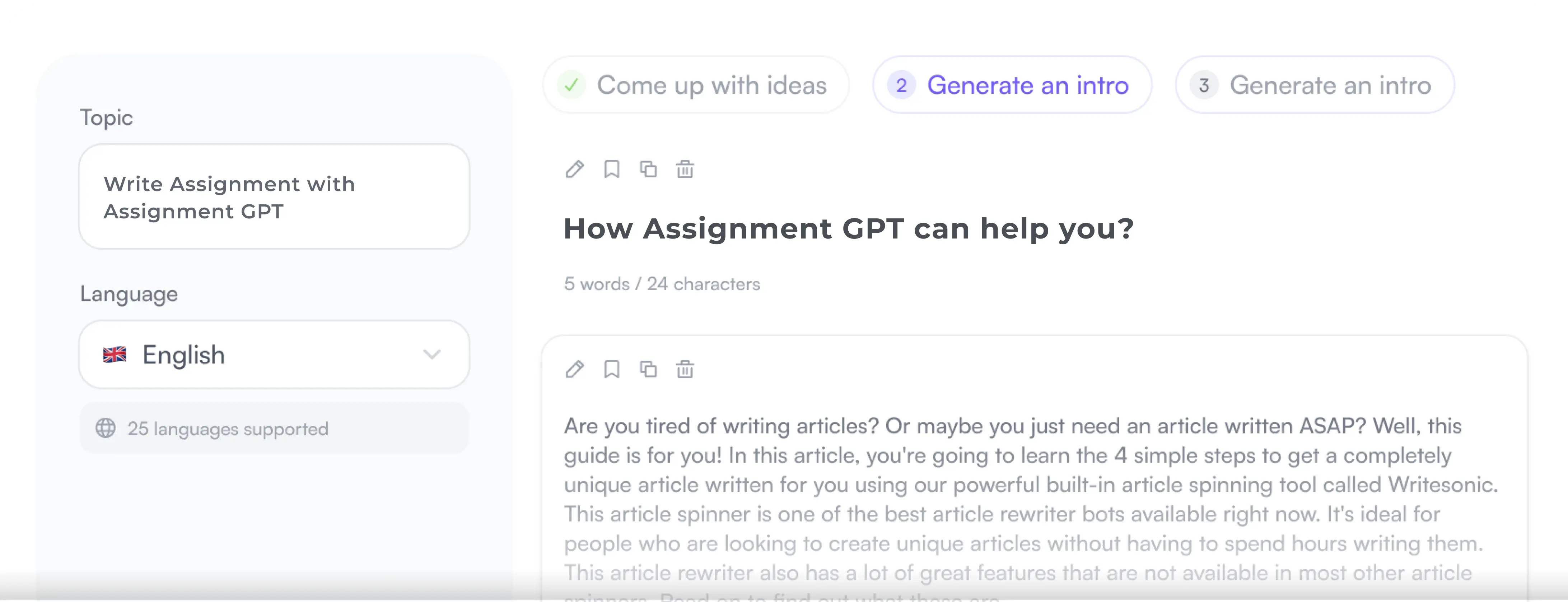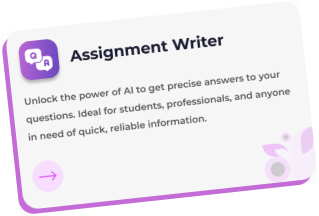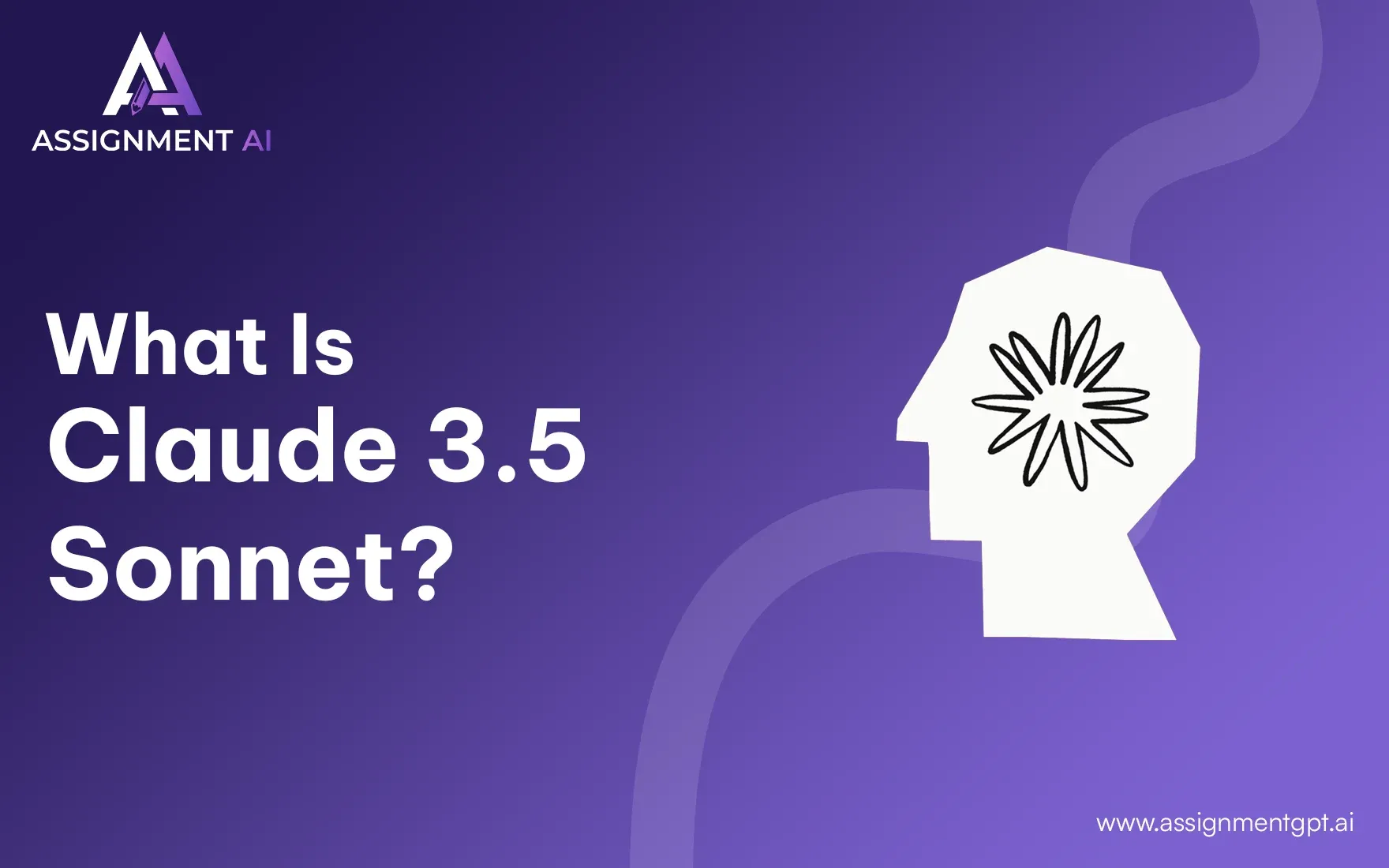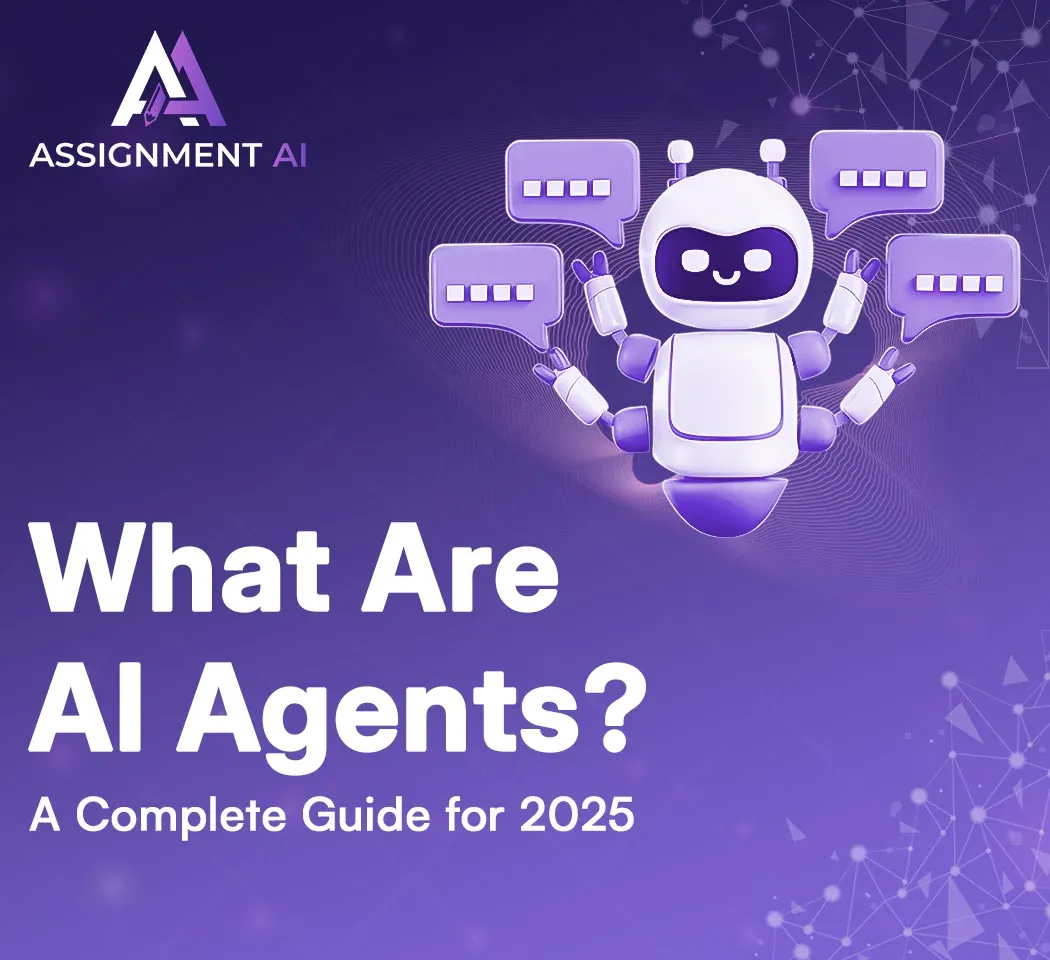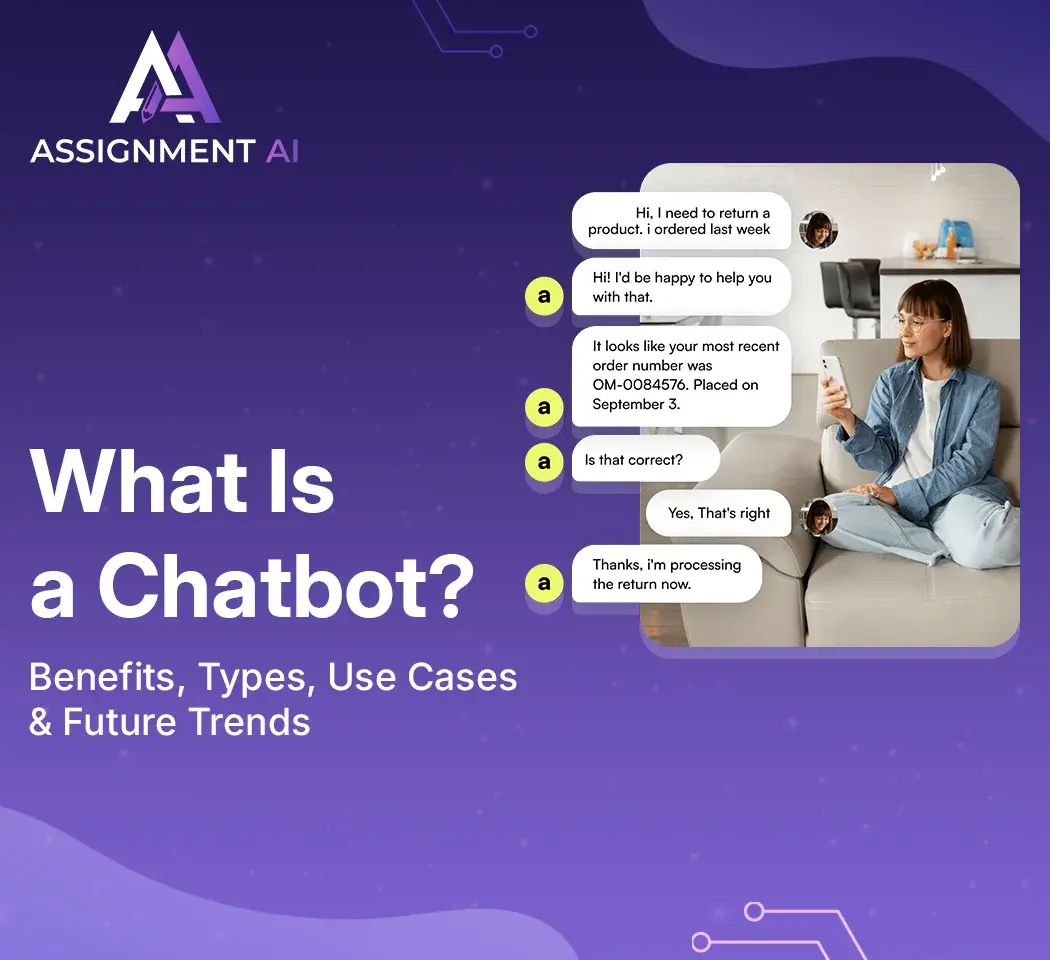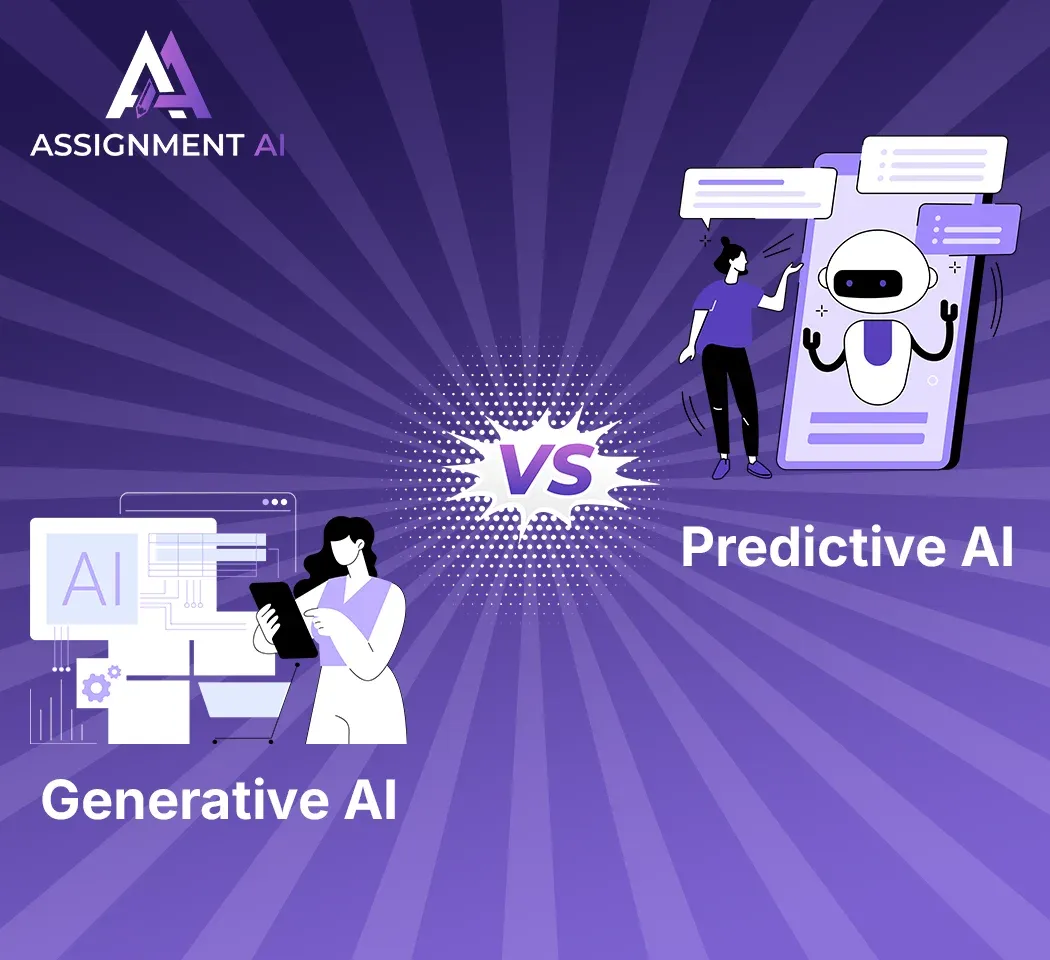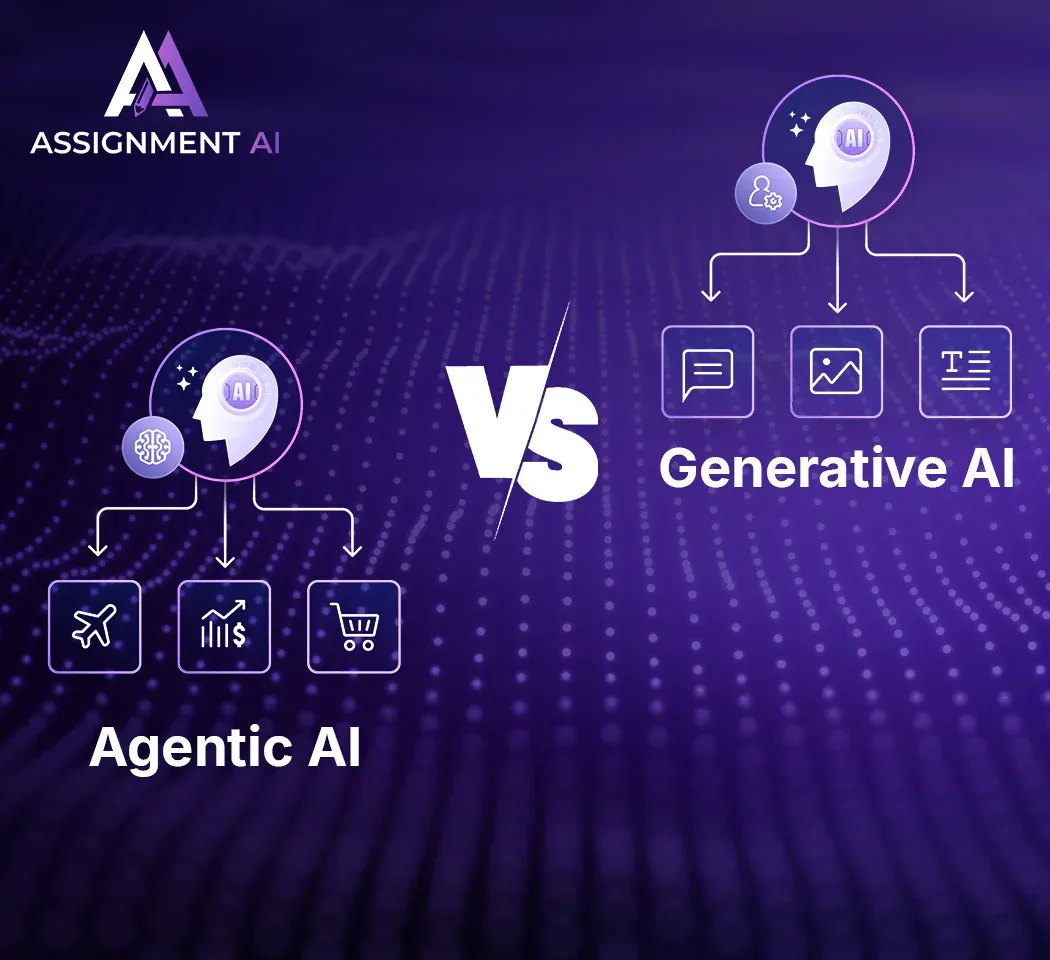AssignmentGPT Blogs
As we already know, Artificial Intelligence is increasing at a very fast pace, every few months, a new frontier is broken, benchmarks are smashed, and the landscape of human-computer interaction transforms. Among the latest breakthroughs, one name stands out Claude 3.5 Sonnet, the most advanced release in Anthropic’s Claude series. And the best thing about this model is that its understanding and learning capabilities are quite advanced.
Launched as part of the Claude 3.5 model family, Claude 3.5 Sonnet pushes the limits of what AI can do, particularly in vision understanding, coding, and autonomous task execution. Whether you’re an engineer, a content creator, a data scientist, or a business owner looking to integrate AI into customer support, Claude 3.5 Sonnet has something unique to offer. I have personally used this model in my web project and I found it really great, compared with other traditional models.
Quick Summary
Claude 3.5 Sonnet is the latest AI model from Anthropic, known for its impressive performance in reasoning, vision, and coding, and this model's learning and understanding capabilities have significantly improved compared with previous versions. It introduces Computer Use Mode, enabling it to control desktops and perform real tasks on-screen. Claude 3.5 Sonnet significantly outperforms previous versions and even beats GPT-4o and Gemini Pro 1.5 in several benchmarks. And this model is also very good at excels in document Q&A, chart interpretation, visual presentations, and coding tasks. The model also includes "Artifacts", a feature that turns AI outputs into interactive assets. And if you are associated with the IT field then you would know that these Customer Support attributions are used for writing assistance for IT support. So let's know into more detail about Claude 3.5 Sonnet so that you can get complete information.
What Is Claude 3.5 Sonnet?
Claude 3.5 Sonnet is a powerful large language model built by Anthropic, launched in June 2024. It is part of the Claude 3.5 family of models and sits in the mid-tier of the product line between the upcoming Claude 3.5 Haiku and Claude 3.5 Opus. It's more than just an incremental update; Claude 3.5 Sonnet marks a significant leap forward in multimodal capabilities, especially visual comprehension, coding, and human-like communication. And this model is also so popular among students because its vision capabilities are very good and in this you get many features like artifacts which make it more advanced for today's time.
And this model is also known for its safety standards, so that whatever training and beta version you release should be within a safety limit. To see how Claude has evolved, our article on Claude 3.7 Sonnet explores the next iteration with enhanced capabilities.
How Does Claude 3.5 Sonnet Perform?
Claude 3.5 Sonnet has delivered record-breaking performance across multiple industry-standard benchmarks. Compared to its predecessor, Claude 3 Opus, and even market leaders like GPT-4o and Gemini Pro 1.5, Claude 3.5 Sonnet sets new standards because its accuracy of learning, reasoning and understanding any new thing is quite sharp.
Claude 3.5 Sonnet outperforms across the board, especially in agentic tool use, math, and code. Its capabilities make it highly reliable for enterprise applications, including IT troubleshooting, knowledge management, and customer service. Many IT fields that employ error-fixing humans can perform this model quite easily and instantly after training.
Claude 3.5 Sonnet’s Impact on AI Capabilities
Claude 3.5 Sonnet isn't just a better LLM, it marks a paradigm shift in how AI can assist humans. Basically this model impact reaches across three major areas.
1. Elevating Vision and Multimodal Reasoning
Claude 3.5 Sonnet is Anthropic’s strongest vision model to date. It doesn't just read text it interprets diagrams, decodes charts, transcribes text from images, and processes visual data alongside natural language. This opens new doors for industries like retail, logistics, finance, and education, where visuals play a key role. And it scans and understands all the data with great accuracy.
2. Agentic Capabilities and Tool Use
The model’s benchmark-leading score in TAU-bench means it can use tools, like performing tasks in a browser or desktop better than any previous AI. From automating workflows to solving IT issues remotely, Claude 3.5 Sonnet acts rather than just suggests. As we saw in previous models, it worked more on suggestions, but this model also acts according to the data along with suggestions.
3. Emulating Human-Like Conversation
Claude’s tone and structure are warm, compassionate, and remarkably relatable. It captures nuance, humour, and even sarcasm, making it a perfect assistant for writing, customer service, and therapy-related applications. This deep understanding is what makes it better than other platforms because it deviates from normal conversation. Human emotion has given the answer according to the word.
The Technology Behind Claude 3.5 Sonnet
While Anthropic hasn’t released full technical specifications, we know several key innovations drive this model’s performance:
1. Advanced Training Techniques
Claude 3.5 Sonnet was trained on massive datasets of text, code, and visual inputs, and fine-tuned using live screenshots. It learns not just from language but from user interfaces and desktop environments, so it easily knows how to control the computer.
2. Computer Use Mode
This is the main headline feature of this model and this model uses few combinations which include Pixel-level analysis, Shell commands and xdtools (for interacting with GUI elements). Claude can edit files, move the mouse, browse the internet, and even write and execute code on a live system.
3. Artifacts Interface
This new interface allows users to generate interactive output like code snippets, charts, or presentations and then edit or expand them in real-time.
It creates a new collaborative way to work with AI.
4. Large Context Window (200K tokens)
This gives Claude 3.5 Sonnet the ability to remember long conversations, handle large documents, and maintain in-depth context across tasks. And this will prove to be quite a revolutionary feature because currently, you too might have faced this issue that whenever you chat with any Chatbot and whenever you create a new conversation, it does not remember the previous old conversations, but the model can easily fix this issue.
Use Cases and Applications
Claude 3.5 Sonnet is not just theoretical, it is already in action across industries. So let’s find out where it is being used so you can use it in your work or business.
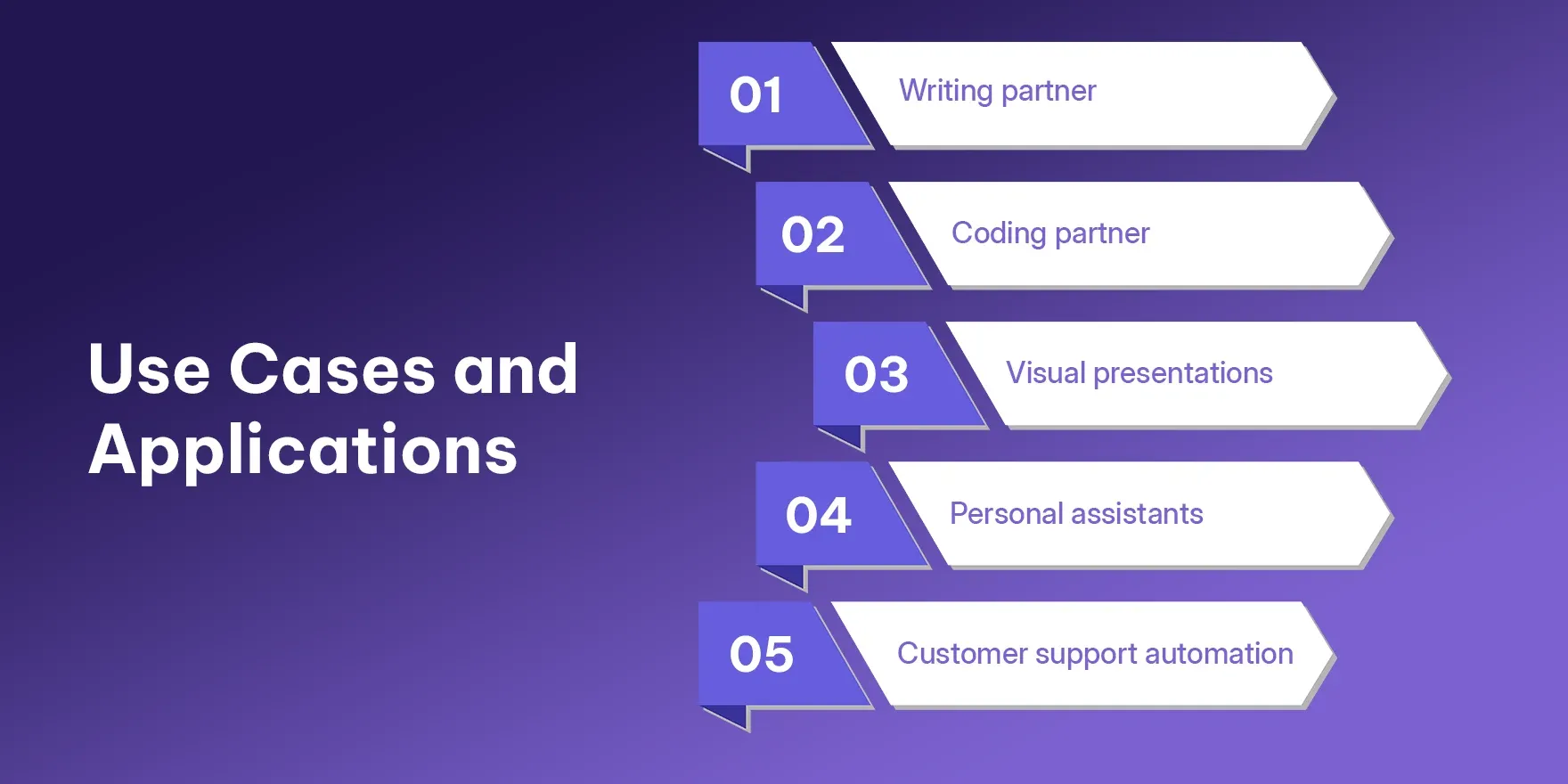
1. Writing Partner
Claude excels in writing with natural tone and flair. Whether it’s emails, blog posts, books, scripts, or creative fiction, it adapts to your voice. This model is also excellent because once you have taught this model your writing style, then after that much of your work can be done on your behalf. And it is also excellent for generating long documents, suggesting titles, summaries, and outlines. And when you start a conversation then you will definitely notice that this model is talking with quite human emotion.
2. Coding Partner
Claude 3.5 Sonnet is a dream companion for developers because it understands natural-language coding tasks and writes, debugs code in multiple languages, Translates old codebases, and Integrates with offline IDEs and this fixes bugs and adds features using agentic coding, It scored 93.7% on the HumanEval benchmark, making it one of the most capable coding AIs available today. Developers exploring various AI coding tools should check out AI code generator options for specialized development assistance.
3. Visual Presentations
One standout use case is Claude’s ability to turn data into presentations, and it understands graphs and tables along with it and it converts them into slide decks using frameworks like Reveal.js and it designs with layout, color, and structure in mind. Apart from this it can also generate interactive infographics. This makes it a powerful tool for teachers, marketers, and analysts who need fast visualizations.
4. Personal Assistant
Claude 3.5 Sonnet can be used as a smart, multi-functional assistant that manages your schedule, sends follow-up emails in your tone and way, answers your messages with tone control, besides it understands and executes multi-step instructions. It also supports integration into platforms like Claude.ai, Amazon Bedrock, and Google Cloud’s Vertex AI, so that you can easily use it in your works.
5. Customer Support Automation
This model is known for its understanding, hence Cloud 3.5 Sonnet is widely used for automation like visual processing, and task execution and it is ideal for automating customer service, this model resolves tickets, interprets charts and documents sent by users, guides users through troubleshooting and this model understands knowledge base content deeply, and it answers the customer in a very human tone and manner.
Benefits of Using Claude 3.5 Sonnet
Cloud 3.5 Sonnet is not just an upgrade, it represents a transformational leap in AI usability, integration, and reliability. This model will greatly enhance the understanding of AI and humans, and you will definitely notice this if you test this model yourself. So let's learn about its important benefits, and whether you are an AI creator, a developer, a businessman, or a researcher, this will definitely come in handy to you.

1. Better Adaptability and Conversational AI
One of the strongest traits of this model is how natural and adaptive it feels in conversation, and if you converse with it you will also notice that it shifts its tone according to your input. And it responds empathetically, making it perfect for mental health support, customer interaction, and teaching. And it also remembers long and old conversations so it easily maintains context better in long dialogues, and it understands humor, idioms, metaphors, and sarcasm. All this adaptability makes conversations more human and relatable, and you did not see this in previous models.
2. Improved Efficiency in Automation and Workflows
Cloud 3.5 Sonnet is not just good at answering questions, it executes tasks. This can dramatically boost efficiency in many fields, it automates customer support with deep context understanding. And it writes, edits, and tests code for you on its own. And it can easily perform repetitive computer tasks using computer-use mode. Along with this, it helps you generate and manage documents, emails, and workflows. Teams that use cloud have saved a lot of time, and their productivity level has also increased significantly.
3. Enhanced User Interaction with AI Models
With the Artifacts feature, Claude 3.5 Sonnet introduces a completely new way to interact with outputs, When you generate something (like code, slides, designs), it shows up in an editable window. In which you can interact, modify, and iterate in real-time. This makes Claude more than a chat agent, it becomes a visual co-worker. It also ensures that outputs are cleanly organized, presented beautifully, and directly usable in professional settings.
Potential Limitations and Challenges
Even though Claude 3.5 Sonnet is a powerful AI system, it’s not without limitations. And knowing this helps you in setting realistic expectations and designing smarter workflows.
1. Usage Limits and Pricing
While Claude 3.5 Sonnet is free to try on Claude.ai, also it comes with limitations, In this, you will get limited prompt Usage. Heavy usage requires a Claude Pro or Team subscription. API usage incurs costs, $3 for million input tokens and $15 for a million output tokens, which can add up. And this can be quite expensive for small-scale startups.
2. Limited Memory
Although it has a massive context window (200K tokens), Claude currently doesn’t retain memory between sessions (unless implemented with external tools). This affects long-term personalization and historical learning. This is why they have announced that to maintain storage and processing, Anthropic is working on a "Memory" feature to address this, but as of now, it's not fully released.
3. No Offline Access or Desktop App
Unlike some tools, Claude 3.5 Sonnet doesn’t have a native desktop app. It requires an internet connection and works only through, Claude.ai (browser), Anthropic API, aur Amazon Bedrock or Google Vertex AI, and this limits its accessibility for use cases in offline or restricted environments.
4. Visual Capabilities Still Evolving
While it beats most models in visual Q&A and vision reasoning, Claude still slightly lags behind GPT-4o in specific tasks like, Science diagram interpretation and in this you can also create Chart visualization in highly specialized domains but their effectiveness is not much useful good. These gaps are narrowing fast but should be considered in niche applications.
Sonnet vs GPT-4o vs Gemini Pro 1.5
Whether you're a businessman or a new startup founder, pricing often plays a decisive role in choosing an AI model. So, let's compare Claude 3.5 Sonnet with its top competitors.
| Features | Claude 3.5 Sonnet | GPT - 4o (OpenAi) | Gemini Pro 1.5 (Google) |
|---|---|---|---|
| Monthly Plan (Basic) | $20 | $20 | $20 |
| API Input Cost | $3/Million Tokens | $5/Million Tokens | Not publicly specified |
| API Output Cost | $15/Million Tokens | $15/Million Tokens | Not publicly specified |
| Context Window | 200 Tokens | 128K Tokens | 1M+ Tokens |
| Vision capabilities | Advanced (Charts, Docs and Screenshot) | Advanced (Images, Audio) | Advanced |
| Artifacts / Interactive UI | Yes | No | No |
Claude offers a compelling balance of cost, speed, and capability, especially for developers and enterprises focused on integration and visual understanding. If you are a developer, then this model greatly improves your work and increases productivity, as it is more cost-effective and advanced than other models.
How the New Claude 3.5 Sonnet Enhances Customer Support
This model is impactful in many sectors but customer support is one of the most impactful use cases for Claude 3.5 Sonnet. Traditional support chatbots are often rigid, impersonal, and limited to templated responses. So let us know in detail how Claude 3.5 Sonnet is making an impact in the customer support sector so that if you also have this requirement in your business then you can use this model.
1. Computer Use for IT and Troubleshooting
Claude 3.5 Sonnet can literally use your computer, which is revolutionary for IT support and it navigates through your system files and it executes commands via shell. With this it troubleshoots browser or app-based issues. This Model can Fills forms, submits tickets, installs updates, This makes it ideal for remote diagnostics and real-time problem-solving, reducing the need for human intervention.
2. Empathetic and Human-like Responses
I have personally tested this model and according to me its behaviour, response and tone make it more effective than other models. The most important thing is that it has very calm and accurate features to respond to how the user wants to behave. And it provides detailed explanations to the user instead of robotic replies. Handles sensitive topics with care and clarity, This is especially beneficial for healthcare, finance, or mental health apps where tone matters deeply.
3. Deep Understanding of Knowledge Bases
Claude can ingest and understand long documents a skill that enhances, Internal FAQ answering, SOP retrieval, Compliance assistance. You can feed it manuals, guides, or SOPs, and Claude will return accurate, contextual questions ho or fr complex, ye answer quite accurately.
4. Visual Support
If this model gets a customer who sends a screenshot of an error or a chart, Claude 3.5 Sonnet can read and interpret screenshots and explain data charts and graphs along with it and diagnose issues shown in visual form. This makes it incredibly valuable for tech companies, SaaS tools, and analytics dashboards.
5. Robotic Process Automation (RPA)
Beyond answering, Claude can act filling forms, submitting documents, tagging emails, and more. This model automates email ticketing systems, integrates with CRMs and orchestrates workflows across tools. This reduces response time and boosts efficiency across support departments.
The Future of Claude 3.5 Sonnet
The release of Claude 3.5 Sonnet is just the beginning of a much larger vision for AI. Anthropic has hinted at an ambitious roadmap that redefines how we collaborate with intelligent systems, this model is also so effective and popular in the market because its intelligence is quite high and its understanding is also much better than previous models, so let us know what the future of Claude 3.5 Sonnet model could be.
1. Memory Integration
A future feature currently in development, "Memory," will allow Claude to, Remember your preferences, Track past conversations. With this we maintain ongoing project context. This will turn Claude from a “smart assistant” into a loyal, evolving teammate.
Full Claude 3.5 Sonnet Rollout: Claude 3.5 Sonnet is the mid-tier model in its series.
Claude 3.5 Haiku: And this Model is expected to be the lightweight, fast-response model for mobile and real-time tasks.
Claude 3.5 Opus: This model is positioned as the heavyweight champion for deep research, multi-modal tasks, and high-volume workloads. The full lineup will allow businesses to choose the best model per need and budget.
2. Expanded Team Collaboration
Claude is evolving into a shared workspace assistant. In which teams can work on documents, charts, or code together, Everyone can see what Claude generates (live), and with this the user gets the feature of collaborative feedback and can refine outputs in real-time, this all team collaboration feature will be a game changer for agencies, dev teams, research groups, and enterprises.
3. Safer, More Transparent AI
Anthropic is serious about AI safety. Therefore Claude 3.5 Sonnet was tested by UK’s Artificial Intelligence Safety Institute, US AI Safety Institute, Red teams focused on abuse prevention. With ASL-2 safety level, it’s among the safest advanced AI tools available today.
4. Continuous Performance Upgrades
Anthropic plans to improve speed, cost-efficiency, and intelligence every few months, setting a new pace for generative AI evolution. Apart from this, you can expect the release of features like increased token limits, Lower latency, and expanded multi-modal understanding in the future.
Conclusion
Claude 3.5 Sonnet is not just another milestone in AI, it is a reimagination of what a digital assistant can be, this model is significantly advanced from previous models with its intelligence, human emotion understanding, and long conversation learning, From processing screenshots to coding full programs, from understanding documents to helping with IT support, Claude 3.5 Sonnet combines speed, intelligence, vision, and empathy in a way we haven’t seen before. Popular traditional platforms can only do chat and conversation but it can use a computer. It enables interactive workflows via the Artifacts interface. This model is designed with safety, transparency, and usability at its core.
FAQs
1. What is Claude 3.5 Sonnet?
2. How does Claude 3.5 Sonnet differ from GPT-4o and Gemini Pro 1.5?
3. What are “Artifacts” in Claude 3.5 Sonnet?
4. Can Claude 3.5 Sonnet be used for customer support?
5. How much does Claude 3.5 Sonnet cost?
6. What kind of tasks can Claude 3.5 Sonnet perform using a computer?
7. Is Claude 3.5 Sonnet safe to use?
8. What's next for Claude 3.5 and Anthropic?
Product Manager at @AssignmentGPT
Ashu Singh, content writer at AssignmentGPT, crafting clear, engaging content that simplifies complex tech topics, with a focus on AI tools and digital platforms for empowered user experiences.
Master AI with
AssignmentGPT!
Get exclusive access to insider AI stories, tips and tricks. Sign up to the newsletter and be in the know!

Transform Your Studies with the Power of AssignmentGPT
Empower your academic pursuits with tools to enhance your learning speed and optimize your productivity, enabling you to excel in your studies with greater ease.
Start Your Free Trial ➤Start your success story with Assignment GPT! 🌟 Let's soar! 🚀
Step into the future of writing with our AI-powered platform. Start your free trial today and revolutionize your productivity, saving over 20 hours weekly.
Try For FREE ➤